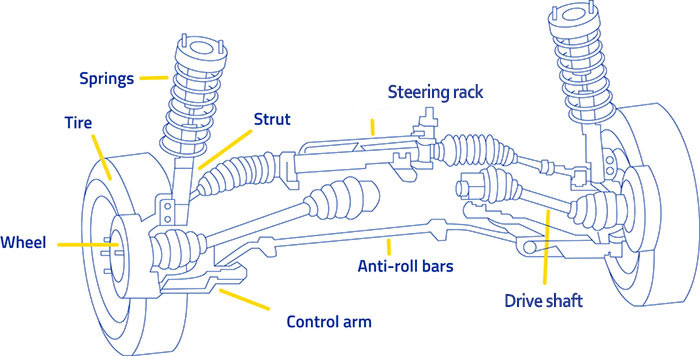Shocks and struts, like other crucial parts of your vehicle’s suspension system, tend to wear down slowly over time. Because this wear happens gradually, it’s easy to overlook the resulting decline in handling, braking efficiency, and overall stability during everyday driving. Factors like road quality, climate, driving habits, and how much weight your vehicle regularly carries all influence how quickly these components deteriorate.
How Does It Work?
A shock absorber works by controlling the movement of a vehicle’s suspension, helping to keep the tires in contact with the road. It does this by converting the kinetic energy from suspension movement into heat energy, which is then dissipated through hydraulic fluid inside the shock. When the vehicle hits a bump or dips, the shock absorber compresses, forcing fluid through small internal valves that resist the motion. This resistance slows down the suspension’s travel, reducing bounce, sway, and vibration, ultimately providing a smoother, more stable ride and improving overall control and safety.
What happens when a shock absorber fails?
Bad shock absorbers can cause several noticeable symptoms while driving. You may feel excessive bouncing after hitting a bump, experience longer braking distances, or notice the front of the vehicle diving forward when braking. The car might sway more during turns, feel unstable at higher speeds, or vibrate through the steering wheel. Uneven tyre wear is also common due to poor road contact. In some cases, you might hear clunking noises over bumps or see fluid leaking from the shocks. These signs indicate it’s time to have the suspension checked for safety and performance.
What should I do with a Foggy Windscreen?
If you suspect your shock absorbers are bad, the best course of action is to have them inspected and replaced as soon as possible. Driving with worn shocks can compromise your vehicle’s handling, braking, and overall safety. Visit a trusted mechanic or suspension specialist who can confirm the issue through a visual inspection and road test. If replacement is needed, it’s generally recommended to replace shocks in pairs (front or rear) to maintain balanced handling. Ignoring the problem can lead to further damage, such as uneven tyre wear, strain on suspension components, and reduced control in emergency situations.





